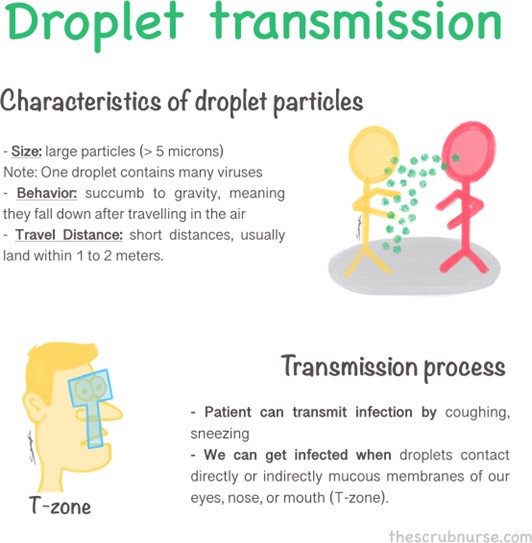A nurse is caring for an infant who has pertussis. Which of the following precautions should the nurse implement?
Airborne.
Droplet.
Standard.
Neutropenic.
The Correct Answer is B
Choice A reason:
Airborne precautions are implemented for diseases that spread through small airborne particles, such as tuberculosis or measles. These diseases can remain suspended in the air for extended periods and be inhaled by others. Pertussis, also known as whooping cough, is primarily spread through respiratory droplets when an infected person coughs or sneezes, making airborne precautions unnecessary.
Choice B reason:

Droplet precautions are appropriate for illnesses that spread through respiratory droplets produced when an infected person talks, coughs, or sneezes. Pertussis falls into this category as it is transmitted mainly through respiratory droplets. By implementing droplet precautions, the nurse will minimize the risk of transmission to others, including healthcare workers and other patients.
Choice C reason:
Standard precautions are the baseline infection prevention practices used for all patients to prevent the spread of infections in healthcare settings. While important, they may not be sufficient to control the transmission of pertussis, as it requires additional measures like droplet precautions due to its specific mode of transmission.
Choice D reason:
Neutropenic precautions are used for patients with compromised immune systems, particularly those with low white blood cell counts (neutropenia). The purpose is to protect these vulnerable individuals from exposure to infectious agents. However, pertussis precautions are different and do not fall under the neutropenic category.
Nursing Test Bank
Naxlex Comprehensive Predictor Exams
Related Questions
Correct Answer is A
Explanation
Choice A reason:
The nurse should provide the client with a carbonated beverage as a nonpharmacologic intervention to reduce pain from intestinal gas. Carbonated beverages, like soda or sparkling water, can help alleviate gas by promoting burping, which releases trapped gas from the digestive system. The effervescence of the carbonated drink can help relieve the discomfort caused by accumulated gas, offering relief to the client.
Choice B reason:
Encouraging the client to lie on their right side is not an effective nonpharmacologic intervention for reducing pain from intestinal gas. Although positioning can sometimes aid in relieving discomfort, lying on the right side does not specifically target the reduction of gas. Therefore, it is not the most appropriate choice in this scenario.
Choice C reason:
Encouraging the client to ambulate is a beneficial nonpharmacologic intervention for various post-operative conditions. However, when it comes to reducing pain from intestinal gas, it may not be as effective as other options. While movement can aid in gas passage through the digestive system, it might not be the most immediate or direct solution for alleviating the client's discomfort.
Choice D reason:
Providing the client with straws for beverages does not directly address the issue of intestinal gas. It is an unrelated intervention and may not provide any significant relief for the client's discomfort.
Correct Answer is A
Explanation
Adolescents tend to believe their own actions might have caused their terminal illness. Choice A reason:
This statement reflects a common developmental focus for adolescents, who are often navigating issues related to identity and self-image. While they are aware of their illness, many may prioritize concerns about how they look and how they are perceived by others. This can be a significant aspect of their experience during a terminal illness.
Choice B reason:
Many adolescents imagine death as a type of monster. Although this statement acknowledges a common perception of death among some adolescents, it is not the best choice for reinforcing teaching about the perception of death in the context of a terminal illness. The focus should be on more concrete and realistic aspects of death and its implications.
Choice C reason:
This statement does reflect a valid concern but may not be as prevalent as the concern with appearance in this age group. Many adolescents, especially in a terminal situation, may focus on more immediate concerns, such as how they are perceived.
Choice D reason:
Many adolescents don't understand that death is permanent. While this statement may be true for some adolescents who are still developing a full comprehension of death, it is not the most suitable choice for this scenario. In the context of a terminal illness, it is essential to acknowledge that the adolescent likely has a clear understanding of the finality of death.
Whether you are a student looking to ace your exams or a practicing nurse seeking to enhance your expertise , our nursing education contents will empower you with the confidence and competence to make a difference in the lives of patients and become a respected leader in the healthcare field.
Visit Naxlex, invest in your future and unlock endless possibilities with our unparalleled nursing education contents today
Report Wrong Answer on the Current Question
Do you disagree with the answer? If yes, what is your expected answer? Explain.
Kindly be descriptive with the issue you are facing.
